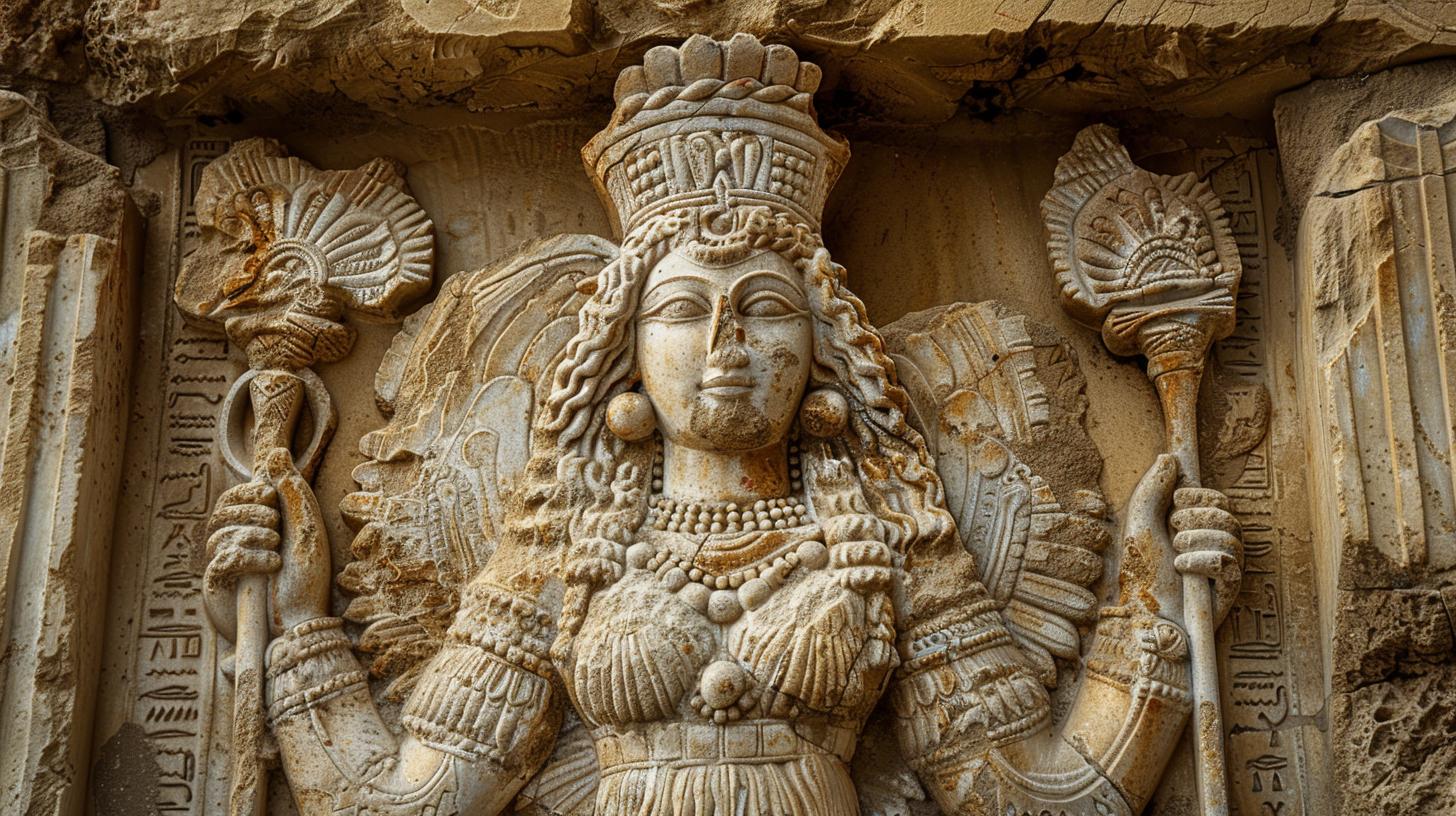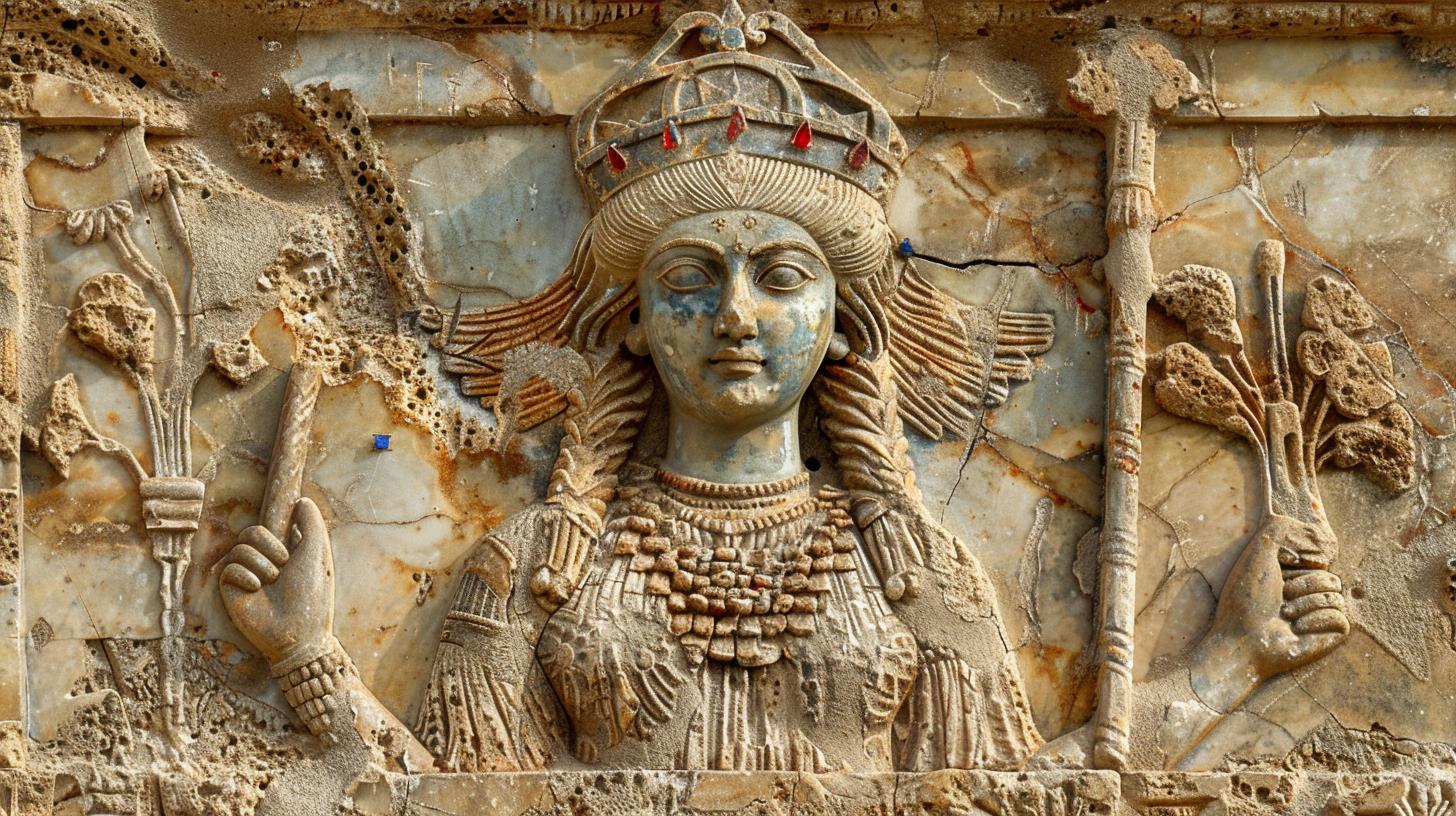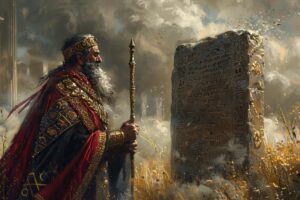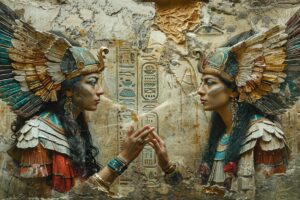Wurusemu: The Sun Goddess’s Role and Evolution in Hittite Culture
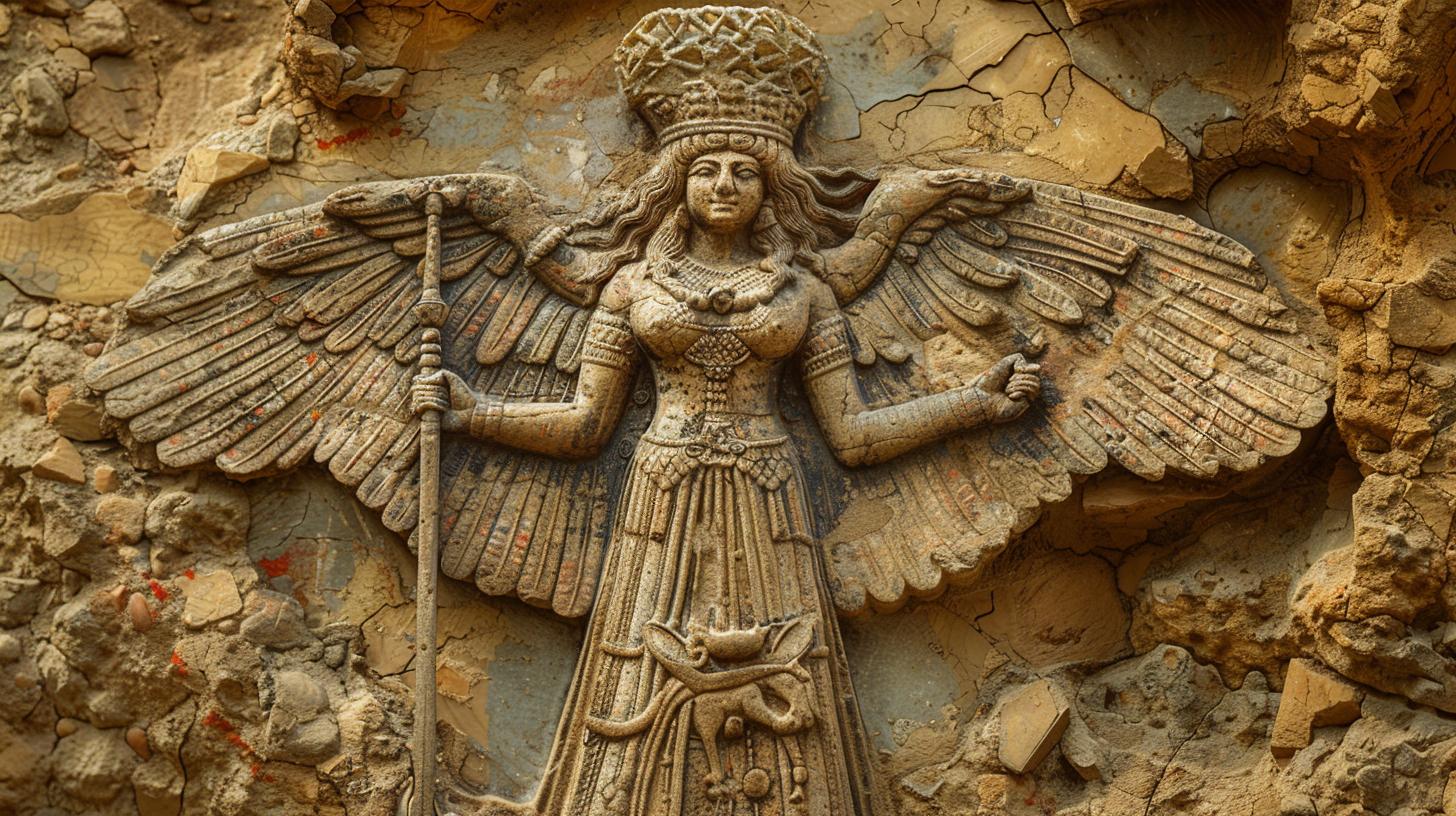
Wurusemu, known as the Sun Goddess, was a central figure in Hittite mythology. Her worship originated in the Hatti culture and was adopted by the Hittites. She was associated with the city of Arinna and played a significant role in their religious practices.
Wurusemu was seen as a motherly figure and a symbol of warmth and sovereignty. Throughout history, her identity and titles evolved, reflecting the cultural influences and religious syncretism of the ancient Near East.
Origins and Early Culture
The origins and early culture revolving around Wurusemu are deeply rooted in the Hatti civilization and later adopted by the Hittites.
Hatti and Hittite Adoption
Wurusemu originated in the Hatti culture before her significance spread to the Hittites after their conquest. As the Hittites assimilated Hatti traditions, they adopted her worship, integrating her into their own pantheon.
The Sacred City of Arinna
The city of Arinna served as the religious center for Wurusemu’s worship. Located in the heart of Hattite-Hittite territory, it was considered a sacred space where numerous ceremonies dedicated to the Sun Goddess were held.
The Sun Goddess’ Roles and Functions
Wurusemu was revered as the Great Sun Goddess, embodying warmth, sovereignty, and compassion. She was a maternal figure, often called the ‘Mother of the Gods,’ and played a pivotal role in legitimizing royal authority.
Importance in Territorial Disputes
Wurusemu’s influence extended to resolving territorial disputes. Her divine favor was sought to settle conflicts and ensure just rulings. Appeals were often made to her during political and land dispute settlements, underscoring her importance in maintaining social harmony and order.
Transformations and Titles
Wurusemu, the Sun Goddess, underwent various transformations and acquired multiple titles throughout history.
Association with Taru
Wurusemu was associated with Taru, the storm god. Together, they symbolized the intertwining of elemental forces. This union reinforced her dominance in the pantheon.
Connection with Cybele and Hebat
Wurusemu’s identity evolved to align with other prominent deities. She was connected to Cybele in the Greco-Roman tradition. Similarly, she corresponded to Hebat in Hurrian mythology, reflecting syncretism.
The Name Kupaba
After 1000 B.C.,
Wurusemu became known as Kupaba. This name might relate to Anatolian Kubebe and Cybele. She was also linked to Hepat, embodying motherly and fertile aspects.
Symbolism and Rituals
The symbolism and rituals associated with the Sun Goddess played a significant role in the religious practices of the Hittites. Various sacred symbols, ceremonious objects, and specific animals were integral to her worship.
Sacred Symbols
Among the sacred symbols, the lioness was particularly significant. Additionally, vultures were possibly revered. These symbols highlighted her connection with protection and royalty.
Number 8 and Ceremonies
The number 8 had a distinct ritual importance. Ceremonies often took place in front of eight statues, each representing a previous high-ranking priestess. These rituals were elaborate and designed to honor the sacred feminine aspect.
Importance of the Deer
The deer held a pivotal role in the sun goddess’s cult. It was considered a sacred animal, and cultic vessels shaped like deer were utilized in worship. Queen Puduhepa frequently promised numerous deer in her prayers, underlining their significance in religious ceremonies.
Mythological Family
Wurusemu’s family holds significant importance in Hittite mythology, highlighting her connections with other divine beings.
Daughters: Hulla and Mezulla
Wurusemu’s daughters, Hulla and Mezulla, played essential roles in the mythological framework of the Hittite pantheon.
Roles in the Annual Cycle
Hulla and Mezulla symbolized different phases of the annual cycle. Hulla was linked to the year’s increasing phase, while Mezulla represented the decreasing phase.
Representations of Time
As personifications of time, Hulla and Mezulla embodied the eternal cycle of nature. They were connected to the rhythm of life and death in the natural world.
Sons of Wurusemu and Taru
Wurusemu, in union with the storm god Taru, bore sons who were significant deities.
Gods of the Climate
Their sons were associated with climatic elements. They held dominion over weather patterns and influenced agricultural success and general well-being within Hittite society.
Evolution in Different Cultures
Wurusemu’s identity evolved significantly across different cultures, reflecting adaptation and integration.
Wurusemu in Hurrian Tradition
In Hurrian tradition, Wurusemu was identified as Hepat. This Hurrian goddess was revered similarly, associated with motherhood and fertility. The syncretism highlights how Wurusemu retained her essential qualities while adapting to different cultural contexts.
Transition to Kupaba
After 1000 B.C., Wurusemu was also known as Kupaba. This name change indicates a shift in her worship and attributes. Kupaba, linked to the Anatolian deity Cybele, symbolized the earth and fertility.
This transition represents the blending of various religious practices and beliefs.
Hypothetical Links to Other Deities
Some hypotheses suggest connections between Kupaba and other deities. For example:
These possible links underline the broad influence and adaptation of Wurusemu’s identity through different cultures and eras.
The Sun Goddess of Arinna
The Sun Goddess of Arinna, a major deity in the Hittite pantheon, held a significant position in religious and political contexts.
Principal Deity of Arinna
The Sun Goddess was revered as the primary deity in Arinna, a sacred city within the Hittite kingdom. As the central divine figure, she held immense importance in state rituals and was considered a source of authority and legitimacy for Hittite kings.
Conflation with Ištanu
Over time, the Sun Goddess of Arinna was syncretized with Ištanu, reflecting cultural integration. Ištanu, originally a Hattian deity, came to represent the divine embodiment of solar power, merging identities with the Sun Goddess of Arinna.
Rituals and Ceremonies Performed by Kings
Hittite kings frequently performed rituals and ceremonies in honor of the Sun Goddess, seeking her blessings for their reign and military endeavors. These royal rituals highlighted their devotion and emphasized their divine right to rule.
- Swearing Oaths
- Offering Sacrifices
- Celebrating Festivals
Through these practices, the relationship between the monarch and the goddess was solidified, ensuring the continuity of divine favor and royal authority.
Mythology and Historical Texts
In Hittite mythology, the Sun Goddess Wurusemu features prominently in various narratives and religious texts.
This section explores her depiction in myths and the prayers dedicated to her.
Wurusemu in Myths
Construction of Her House
One fragment of Hattian myth mentions the construction of Wurusemu’s house in Líhzina. This house symbolized her sanctity and connection with the divine realm.
The Apple Tree in a Well
Another mythological reference involves Wurusemu’s apple tree located in a well. This imagery is rich with symbolic meanings, possibly connected to fertility and prosperity.
Prayers and Hymns
Puduhepa’s Devotions
Queen Puduhepa, the wife of Hattusili III, held Wurusemu in high regard. Her prayers often glorified the goddess, acknowledging her as the supreme deity of the land and invoking her blessings for prosperity and protection.
These devotions highlight the integral role of Wurusemu in Hittite religious practices and the personal devotion of the queen to the Sun Goddess of Arinna.
Syncretism and Religious Integration
Wurusemu’s worship demonstrates significant religious syncretism and integration with neighboring cultures, particularly the Hurrians.
Syncretism with Other Deities
Wurusemu was often associated with various deities from different cultures. She became linked with Cybele in the Greco-Roman world and Hebat in Hurrian mythology. This blending of identities showcased the adaptability and widespread influence of her worship.
Integration with the Hurrians
Wurusemu’s syncretism with Hurrian deities marked a crucial element of her worship. Known as Hepat in Hurrian texts, she retained a significant position alongside Hurrian gods. This integration played a pivotal role in the religious landscape of the region.
Cultural and Religious Influence on Hittites
Syncretism influenced not just Wurusemu’s identity but the broader Hittite religious practices. This integration with neighboring cultures enriched the Hittite pantheon, reflecting a fusion that shaped their belief systems deeply.
Examples include:
- Adoption of Hurrian ritual elements
- Influence on Hittite kingship and state ceremonies
- Representation of fertility and nature worship incorporating foreign symbols
Influences and Legacy
Wurusemu’s influence extended deeply into various aspects of Hittite society, culture, and politics.
Influence on Hittite Kingship
Wurusemu played a crucial role in legitimizing the authority of Hittite kings. The connection between the Sun Goddess and the king was solidified through rituals and ceremonies, showcasing the king’s devotion and dependence on her divine favor.
Role in Fertility and Nature
The Sun Goddess was intrinsically linked to fertility and the natural world. She governed the cycles of planting and harvest, ensuring the land’s productivity. Her benevolence was invoked in agricultural rites, thanking her for the bounty and praying for continued prosperity.
Military and Political Assistance
Wurusemu’s divine intervention was sought in military endeavors and political disputes. Victorious battles were often attributed to her support, reinforcing her role as a protector of the Hittite state and its sovereignty.

